5 tendances en matière de primes de voyage qui redessineront la carte des primes de voyage
Découvrez les cinq principales tendances en matière de récompenses de voyage pour 2024 ! Gardez une longueur d'avance en découvrant les dernières innovations en matière de programmes de récompenses de voyage.
Les primes de voyage offrent quelque chose d'unique : la possibilité de créer des souvenirs durables. Contrairement aux biens matériels, qui peuvent s'estomper ou devenir obsolètes, les expériences vécues au cours d'un voyage peuvent faire partie de l'identité d'une personne et de ses souvenirs les plus chers.
En fait, ce rapport indique que 43 % des clients dans le monde préfèrent les expériences aux biens matériels et que 78 % d'entre eux accordent une plus grande valeur aux expériences vécues dans le monde réel.
Cette préférence met en évidence l'évolution vers une consommation expérientielle et l'importance croissante de proposer des expériences de voyage dans le cadre d'un programme de récompenses.
Si nous nous tournons vers l'avenir, il est clair que les programmes de récompenses pour les voyages changent de vitesse, deviennent plus innovants et plus centrés sur le client. Voyons ensemble comment ces changements sont susceptibles d'alimenter la fidélité des clients dans les années à venir.
Les compagnies aériennes et les hôtels n'ont pas créé des programmes de fidélisation des voyageurs uniquement pour le plaisir ; ils sont devenus un élément crucial de leur modèle économique. Saviez-vous par exemple qu'en 2019, le programme MileagePlus de United a vendu pour 3,8 milliards de dollars de miles à des tiers comme les banques ? Oui, les banques donnaient ensuite ces miles en récompense à vous, le dépensier.
American Airlines et Marriott n'étaient pas loin derrière, rapportant des milliards grâce à leurs programmes de fidélisation. Ces programmes ont connu un tel succès qu'ils sont devenus des unités commerciales à part entière, avec des objectifs de rentabilité et des états financiers.
5 tendances qui modifieront les programmes de primes de voyage en 2025
Ces tendances en matière d'attribution d'années de service modifient notre façon de concevoir la reconnaissance des employés. Il ne s'agit plus seulement d'une question d'ancienneté, mais de créer des expériences significatives et mémorables qui ont un impact sur l'individu.
1. Les primes de voyage personnalisées vont changer la donne
Imaginez que vous vous connectiez à votre programme de primes de voyage et que vous soyez accueilli par un message disant : "Nous avons remarqué que vous aimez les vacances à la plage en hiver. Voici une offre spéciale pour une station balnéaire à Bali avec en prime un surclassement dans une suite, juste pour vous".
Réfléchissez au degré de personnalisation du message ci-dessus. Comment vous sentez-vous ? Apprécié à sa juste valeur ? Compris ? Peut-être même ravi ? Ce niveau de personnalisation va au-delà des points et des miles génériques ; il s'agit de créer une expérience enrichissante qui résonne avec les préférences, le comportement et les habitudes de voyage de vos clients.
Les avantages d'une telle personnalisation sont doubles
- Pour les clients, cela signifie recevoir des offres et des récompenses qui correspondent réellement à leurs intérêts et à leurs désirs, tout en rendant leurs voyages plus agréables et plus satisfaisants.
- Pour les programmes de récompenses de voyage, cela se traduit par des taux d'engagement plus élevés, une plus grande satisfaction des clients et, en fin de compte, une plus grande fidélité.
Comment mettre en place la bonne plateforme de récompenses pour la personnalisation ?
La mise en œuvre de la bonne plateforme de récompenses pour la personnalisation est cruciale pour les entreprises qui cherchent à améliorer l'engagement et la fidélité des clients sans avoir à investir des sommes considérables dans des ressources de développement. Une plateforme qui offre la personnalisation esthétique, la personnalisation des emails de récompenses et la possibilité de créer des marques blanches peut considérablement rationaliser ce processus.
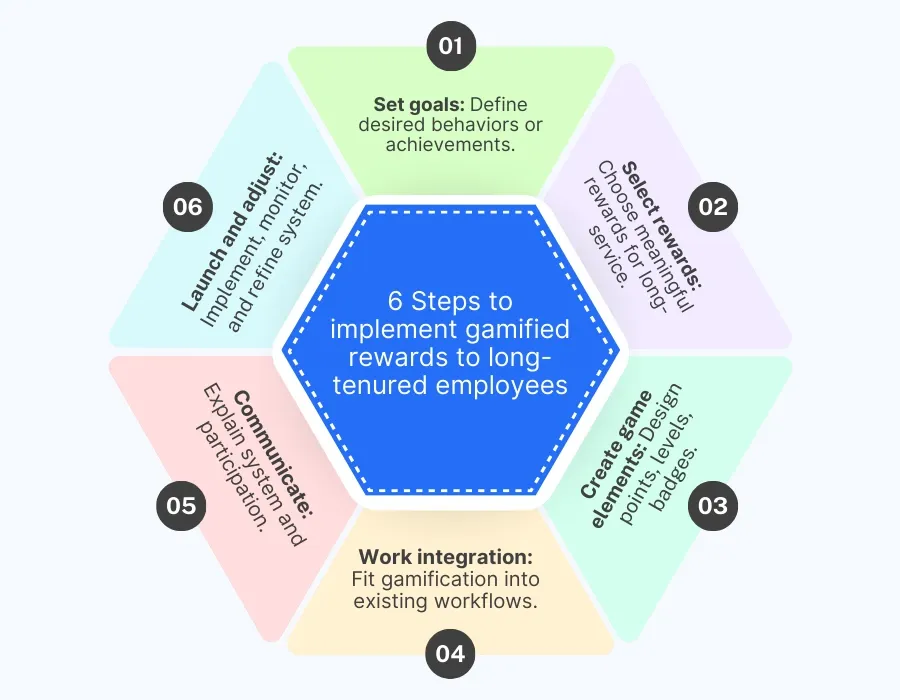
Voici un guide étape par étape qui vous permettra de sélectionner une plateforme répondant à ces critères essentiels.
Étape 1. Évaluer les caractéristiques de personnalisation esthétique
- Identifiez les plateformes dont l'interface est personnalisable : Recherchez des plateformes de récompenses qui vous permettent de personnaliser largement l'interface utilisateur. Vous pouvez notamment modifier les couleurs, la présentation et les éléments pour qu'ils correspondent à l'esthétique de votre marque.
- Évaluer la variété des modèles : Assurez-vous que la plateforme offre une gamme variée de modèles pour les pages de récompenses et les tableaux de bord des utilisateurs. Une bonne sélection de modèles peut vous aider à créer rapidement une apparence attrayante et unique qui trouve un écho auprès de votre public.
Étape 2. Assurer une solide personnalisation des courriels de récompense
- Capacités de contenu dynamique : Choisissez une plateforme qui prend en charge le contenu dynamique dans les courriels, ce qui vous permet d'inclure des récompenses, des recommandations et des salutations personnalisées en fonction des interactions précédentes et des préférences du destinataire.
- Modèles d'e-mails personnalisables : La plateforme de récompenses doit être en mesure de proposer des modèles d'e-mails personnalisables que vous pouvez modifier pour les aligner sur la voix et l'identité visuelle de votre marque. Cette personnalisation s'étend au texte, aux images et à la mise en page.
Étape 3 : opter pour une solution en marque blanche
- Intégration de la marque : Choisissez une plateforme qui offre des capacités de marque blanche, ce qui signifie que vous pouvez marquer le programme de récompenses comme le vôtre, y compris les logos, les schémas de couleurs et les noms de domaine, sans marque tierce visible.
- Intégration transparente : La solution en marque blanche doit s'intégrer de manière transparente à votre site web et à vos systèmes de gestion de la clientèle existants, afin d'offrir une expérience utilisateur cohérente qui semble faire partie intégrante de votre écosystème.
Étape 4 : Rechercher des options sans code ou à faible code
- Interface conviviale : Optez pour une plateforme dotée d'une interface conviviale, de type "glisser-déposer", qui ne nécessite que peu ou pas de compétences en matière de codage. Cette caractéristique permet à votre équipe marketing de créer et de gérer le programme de récompenses sans avoir besoin de l'aide d'un développeur.
- Assistance et documentation étendues : Assurez-vous que la plateforme offre une assistance et une documentation complètes, y compris des guides, des tutoriels et un service clientèle, pour vous aider à naviguer sans effort dans les processus de configuration et de personnalisation.
Étape 5 : Mettre en œuvre et tester le programme pilote
- Programme pilote : Avant de déployer le programme de récompenses à l'échelle de la plateforme, mettez en place un programme pilote avec un segment de votre public. Cette approche vous permet de recueillir des commentaires et de procéder aux ajustements nécessaires.
- Optimisation continue : Utilisez les analyses et les commentaires des clients pour affiner en permanence l'esthétique, la personnalisation des e-mails et l'expérience globale de votre programme de récompenses. La bonne plateforme doit offrir des analyses détaillées pour suivre l'engagement et l'efficacité.
2. Les recommandations de récompenses basées sur l'IA vont propulser la fidélité vers de nouveaux sommets
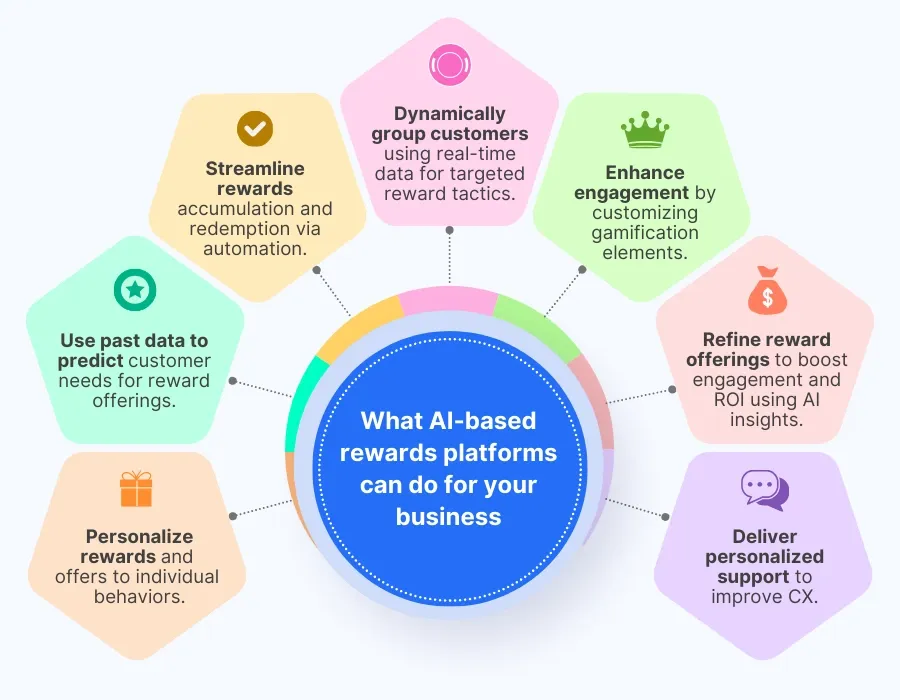
Imaginez que vous marchez d'un bon pas dans l'aéroport, impatient d'arriver à votre porte d'embarquement. Soudain, votre smartwatch vibre d'une notification. Il ne s'agit pas d'un message ou d'un courriel, mais d'une offre de récompense instantanée :
"Vous êtes à quelques pas de notre salon exclusif. Pourquoi ne pas vous y arrêter pour vous détendre avant votre vol ? Voici une carte d'accès gratuite, rien que pour vous".
Les recommandations de récompenses basées sur l'IA sont conçues pour rendre votre expérience de voyage plus agréable et moins stressante.
Ce que les plateformes de récompenses basées sur l'IA peuvent faire pour vous
Les plateformes de récompenses basées sur l'IA exploitent l'intelligence artificielle pour améliorer les programmes de fidélisation, en offrant une expérience personnalisée et dynamique à vos clients. Ces plateformes utilisent des algorithmes d'IA et l'apprentissage automatique pour analyser de grandes quantités de données sur le comportement, les préférences et les interactions des clients.
Voici ce que feront les plateformes de récompenses basées sur l'IA :
- Proposer des offres de récompenses personnalisées : Ils adaptent les récompenses et les recommandations à chaque client en fonction de son comportement, de ses préférences et de son historique d'achat. Cette personnalisation garantit que les clients reçoivent des offres et des récompenses qui sont les plus pertinentes et les plus attrayantes pour eux, ce qui accroît l'engagement et la fidélité.
- Prévoir le comportement des clients : Les algorithmes d'IA peuvent prédire le comportement futur des clients en analysant les interactions passées. Cette capacité prédictive permet aux entreprises d'anticiper les besoins et les préférences des clients, en leur offrant des récompenses et des promotions avant même qu'ils ne les demandent.
- Automatiser les processus de récompense : Ces plateformes automatisent le processus de récompense, depuis l'accumulation de points ou de récompenses en fonction des actions du client jusqu'au processus d'échange. L'automatisation augmente l'efficacité et réduit la probabilité d'erreurs, améliorant ainsi l'expérience globale du client.
- Améliorer la segmentation de la clientèle : Les plateformes basées sur l'IA peuvent segmenter les clients de manière plus précise et dynamique que les méthodes traditionnelles. Elles utilisent l'analyse des données en temps réel pour regrouper les clients en fonction de leur comportement, de leurs habitudes de dépenses et de leur niveau d'engagement, ce qui permet de mettre en place des stratégies de récompense plus ciblées et plus efficaces.
- Optimiser les stratégies de récompense : Grâce à l'apprentissage et à l'analyse continus, les plateformes d'IA peuvent identifier les récompenses et les promotions les plus efficaces pour les différents segments de clientèle. Cette optimisation permet aux entreprises non seulement de fidéliser leurs clients, mais aussi de maximiser le retour sur investissement de leurs programmes de fidélisation.
- Faciliter les interactions en temps réel : Les plateformes basées sur l'IA peuvent interagir avec les clients en temps réel, en leur offrant des récompenses, un retour d'information et une assistance instantanés. Cette immédiateté améliore l'expérience du client, rendant le programme de fidélisation plus réactif et attentif aux besoins individuels.
3. Les récompenses expérientielles vont remodeler les programmes de fidélisation des voyageurs
Que diriez-vous d'échanger vos points contre un cours de cuisine privé avec un chef renommé en Italie, au lieu d'un séjour classique à l'hôtel ? L'évolution vers des récompenses expérientielles n'est pas seulement une tendance, mais le reflet de la quête du voyageur en quête de liens plus profonds et plus significatifs avec le monde.
Ces expériences offrent une nouvelle dimension de la fidélité, où chaque point échangé est un pas vers une nouvelle histoire inoubliable.
Quels sont les facteurs à prendre en compte lors du choix d'une plateforme de récompenses avec des offres expérientielles ?
Lors de la sélection d'une plateforme de récompenses spécialisée dans les offres expérientielles, il est essentiel de prendre en compte plusieurs facteurs. Ces facteurs garantissent que la plateforme s'aligne non seulement sur les valeurs de votre marque, mais qu'elle résonne également avec les désirs de votre public de vivre des expériences uniques et mémorables.
Voici ce qu'il faut garder à l'esprit :
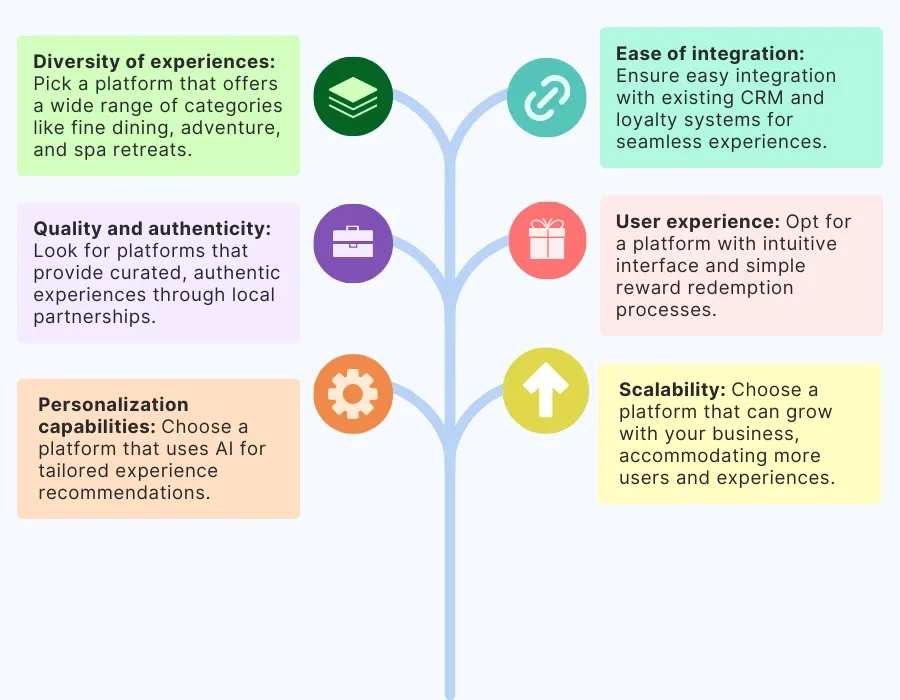
- Diversité des catégories d'expériences : Recherchez une plateforme qui offre une large gamme de récompenses expérientielles. Cela devrait inclure la gastronomie, les divertissements, les activités d'aventure, les visites culturelles, les retraites de spa et de bien-être, et plus encore. Cette diversité garantit que chaque type de voyageur y trouvera son compte.
- Offres sélectionnées : Évaluez la qualité et l'authenticité des expériences. Les meilleures plateformes collaborent avec des experts et des entreprises locales pour proposer des expériences uniques et authentiques, difficiles à trouver ailleurs.
- Capacités de personnalisation: Considérez l'utilisation par la plateforme de l'IA et de l'apprentissage automatique pour personnaliser les recommandations d'expérience en fonction des préférences de l'utilisateur, de son comportement passé et d'autres points de données. La personnalisation améliore l'engagement de l'utilisateur en rendant les suggestions plus pertinentes.
- Facilité d'intégration : La plateforme doit s'intégrer facilement à vos systèmes existants, afin d'assurer une transition en douceur pour votre équipe et une expérience transparente pour vos clients. Vérifiez la compatibilité avec votre CRM, votre programme de fidélisation et d'autres systèmes pertinents.
- L'expérience de l'utilisateur : La plateforme doit offrir une interface intuitive et conviviale, tant pour l'entreprise que pour l'utilisateur final. Cela inclut une navigation facile, des processus de remboursement simples et une assistance à la clientèle accessible.
- Évolutivité : Veillez à ce que la plateforme puisse évoluer avec votre entreprise, en s'adaptant à un nombre croissant d'utilisateurs et à un catalogue d'expériences de plus en plus vaste, sans compromettre les performances.
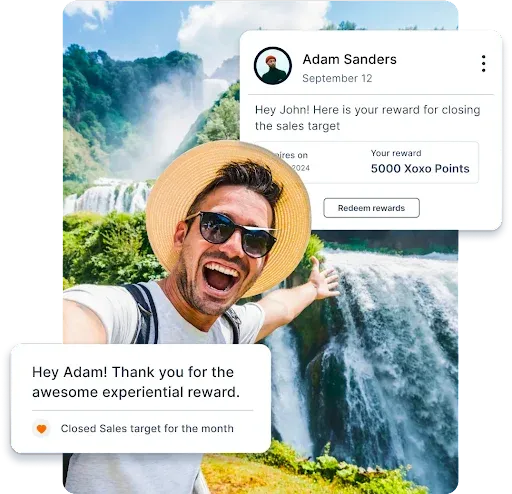
Créez des histoires, pas des transactions ! Transformez les moments en souvenirs grâce à des récompenses expérientielles instantanées.
Explorez des catégories uniques adaptées à divers intérêts, des aventures riches en adrénaline aux retraites de bien-être en toute sérénité. Commencez immédiatement à vivre des expériences enrichissantes.
4. La flexibilité dans le choix des récompenses sera fortement préférée.
Imaginez un monde où vos miles aériens ne servent pas qu'à réserver des vols. Imaginez un système où vous pouvez transférer ces miles vers un programme de fidélité hôtelier, les échanger contre une expérience gastronomique ou même les convertir en billets pour un concert convoité. Grâce à ce niveau de flexibilité, les points ne sont plus une simple monnaie d'échange, mais un passeport vers un monde de possibilités.
Pour les entreprises qui souhaitent adopter cette approche flexible dans leur programme de récompenses, voici un guide étape par étape pour mettre en œuvre une plateforme qui offre un large éventail de choix à vos utilisateurs.
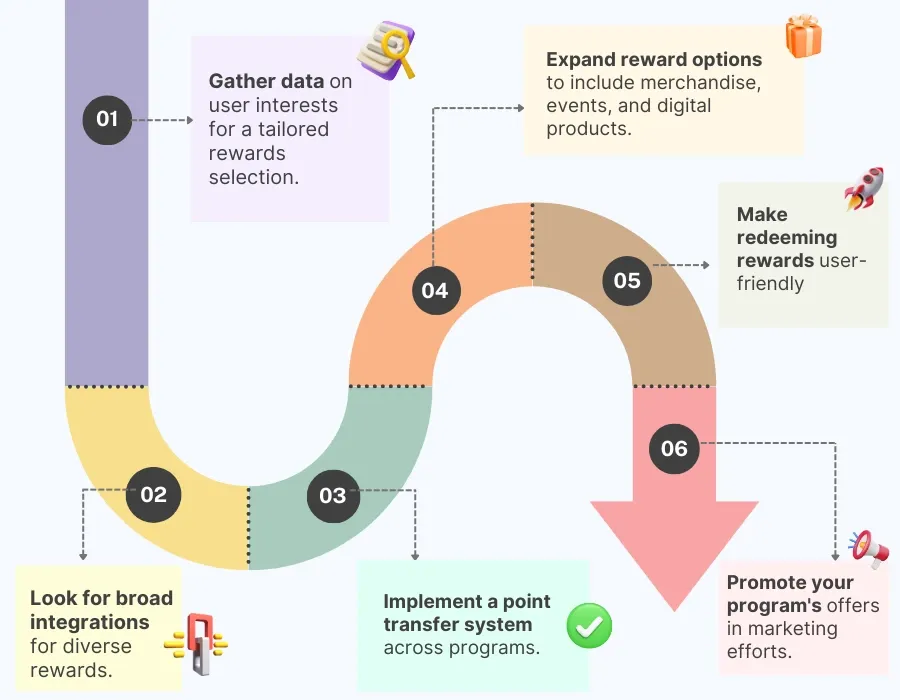
- Étape 1. Évaluez les préférences de votre public : Réalisez des enquêtes et recueillez des données pour comprendre les divers intérêts et préférences de votre public. Cela vous aidera à sélectionner la bonne combinaison de récompenses.
- Étape 2. Choisissez une plateforme polyvalente : Optez pour une plateforme de récompenses qui prend en charge de vastes intégrations avec divers partenaires, ce qui permet d'offrir un large éventail d'options de récompenses, des voyages aux restaurants, en passant par la vente au détail et les divertissements.
- Étape 3. Intégrer un système de points flexible : Mettez en place un système qui permet de transférer facilement des points entre différents programmes et catégories, afin que les utilisateurs puissent utiliser leurs points exactement comme ils le souhaitent.
- Étape 4. Offrez également des options d'échange autres que celles liées aux voyages : Élargissez votre catalogue de récompenses pour y inclure des options autres que le voyage, telles que des marchandises, des billets d'événements et des produits numériques, afin de répondre aux besoins de tous les types de voyageurs.
- Étape 5. Simplifier le processus d'échange : Veillez à ce que le processus d'échange soit simple et convivial, avec des instructions claires et un minimum d'étapes pour convertir les points en récompenses.
- Étape 6. Faites la promotion de votre programme flexible de récompenses de voyage : Utilisez des stratégies de marketing ciblées pour mettre en avant la flexibilité et la variété de votre programme de récompenses, en présentant des exemples concrets d'utilisation des points.
5. Des récompenses adaptées aux nomades numériques pour la main-d'œuvre mobile
Imaginez les possibilités d'un programme de récompenses de voyage qui ne reconnaît pas seulement votre envie de voyager, mais qui soutient également votre mode de vie mobile. L'accès à des espaces de travail en commun, des réductions sur les hébergements de longue durée, des invitations à des événements de réseautage dans le monde entier - ce ne sont pas seulement des avantages, mais des outils essentiels pour tout nomade numérique.
L'objectif est de créer des récompenses qui non seulement fidélisent mais aussi enrichissent considérablement l'expérience de voyage et de travail de manière innovante et durable.
Voici comment faire en sorte que votre plateforme réponde aux exigences de ce groupe démographique unique, en mettant l'accent sur la diversité des offres et la distribution instantanée et sans tracas des récompenses.
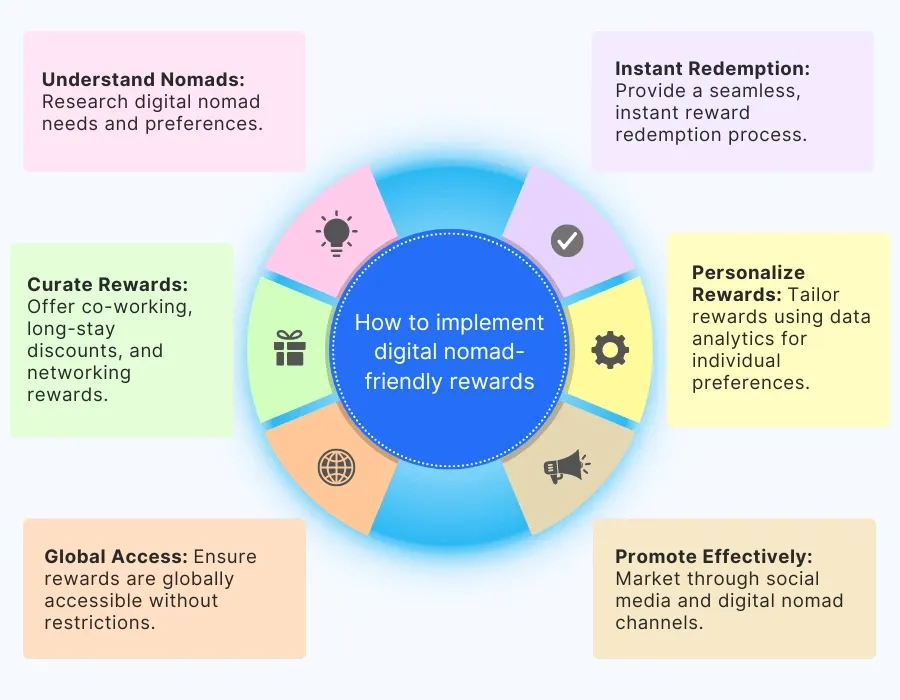
- Étape 1. Comprendre le mode de vie des nomades : Mener des recherches pour comprendre en profondeur les besoins, les préférences et les défis auxquels sont confrontés les nomades numériques.
- Étape 2. Créez des récompenses diversifiées et pertinentes : Sélectionnez des récompenses qui soutiennent directement le mode de vie nomade, telles que l'adhésion à un espace de travail, des offres d'hébergement à long terme et des opportunités de mise en réseau.
- Étape 3. Garantir l'accessibilité mondiale : Établissez des partenariats avec des fournisseurs internationaux pour vous assurer que les récompenses sont accessibles dans le monde entier, sans limites géographiques.
- Étape 4. Offrir un échange instantané et flexible : Mettez en place un processus d'échange basé sur la technologie qui permet aux nomades d'accéder aux récompenses et de les échanger instantanément, quelle que soit la devise ou la situation géographique.
- Étape 5. Personnaliser l'expérience des récompenses : Utilisez l'analyse des données pour offrir des récompenses personnalisées qui correspondent aux préférences individuelles et aux habitudes de voyage des nomades numériques.
- Étape 6. Promouvoir et éduquer : Commercialiser le programme de manière efficace pour atteindre les nomades numériques là où ils se trouvent, en utilisant les médias sociaux, les blogs et les communautés de nomades numériques.
Conclusion
Si l'on se tourne vers l'avenir, la tendance aux récompenses expérientielles, en particulier les voyages, est appelée à se développer. Offrir des voyages en guise de récompenses, ce n'est pas seulement offrir des voyages ; c'est aussi offrir des expériences qui enrichissent la vie, forgent des liens et inspirent la loyauté.
Le marché est concurrentiel, mais les primes de voyage se démarquent nettement, transformant les clients en ambassadeurs de la marque qui partagent leurs histoires et leurs expériences. Les entreprises qui reconnaissent cette tendance et agissent en conséquence ne se contenteront pas d'améliorer l'expérience de leurs clients, mais se constitueront une clientèle fidèle qui considérera sa relation avec la marque comme un voyage rempli d'expériences mémorables.
Grâce à la plateforme de récompenses transparente de Plum, les entreprises peuvent débloquer un monde d'incitations au voyage, en offrant tout, des bons de vol et d'hôtel aux expériences curatives qui stimulent l'engagement et la fidélisation.
Transformez votre stratégie de récompenses avec Plum et créez des expériences qui laissent un impact durable !


















